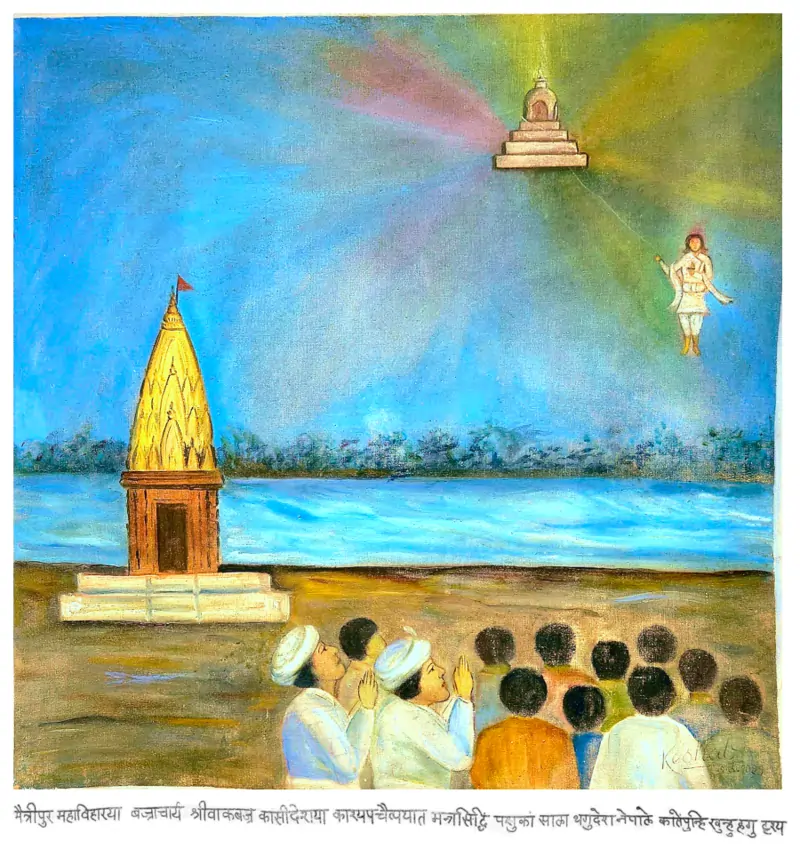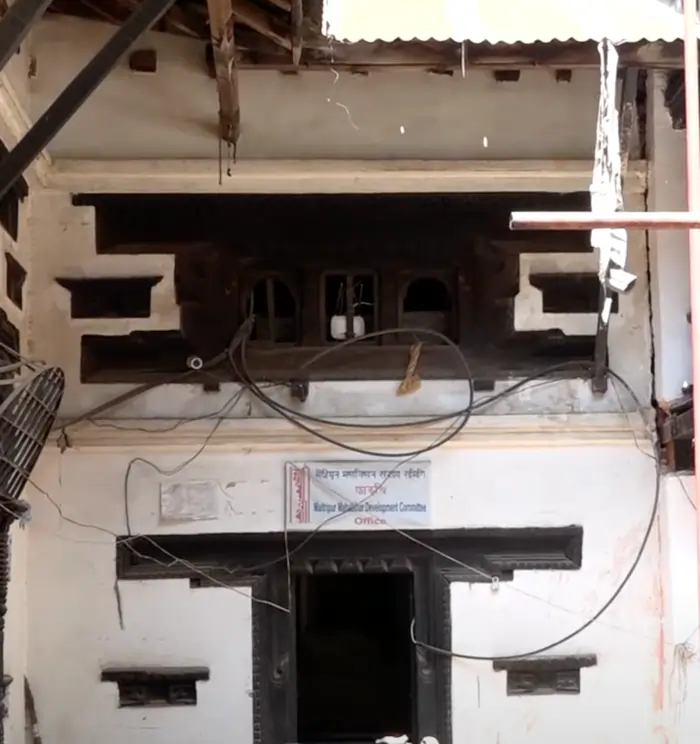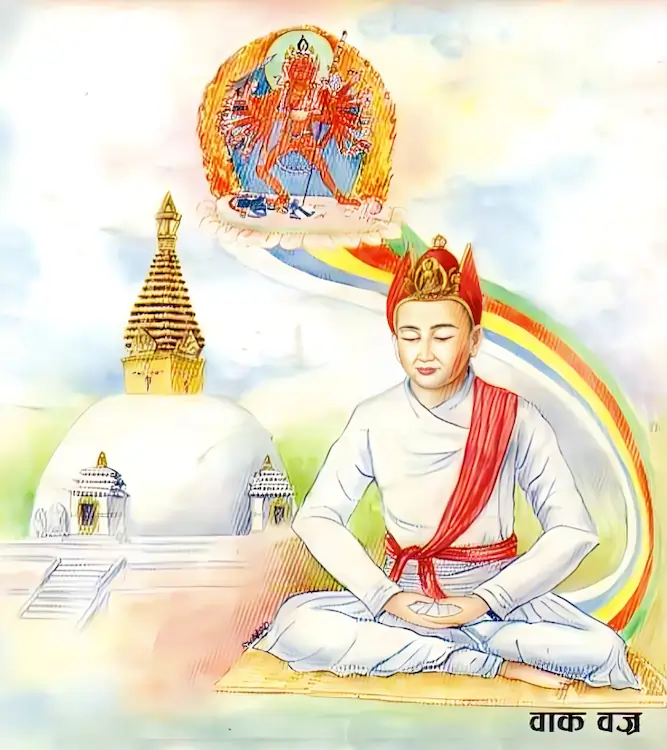The Birth of a Legend
The legend of Wak Bajra Bajracharya, written in Sanskrit as वाक बज्र बज्राचार्य, also spelled as Vak Vajra Bajracharya begins in the 5th Century A.D. in the historic city of Kathmandu, Nepal. He is the founder of Kwabahal, Maitripur Mahavihar in Kathmandu, Nepal. He stands as a pivotal character in the rich spiritual heritage of the Kathmandu valley. Born during the era of the Licchavi Dynasty, a period rich in cultural and religious development, Wak Bajra was destined to leave an indelible mark on the spiritual landscape of his homeland. His name वाक, derived from the Sanskrit words for ‘sound’ or ‘speech’, was a harbinger of the influential role he was to play in the realm of spiritual discourse.

Spiritual Beacon and Mahasiddha
Wak Bajra Bajracharya laid the cornerstone for spiritual enlightenment in Kathmandu by establishing Kwa Bahal, also known as Maitripur Mahavihar. This center wasn’t just a place; it was a hub of learning and spiritual growth, deeply revered in the heart of Kathmandu. Wak Bajra’s expertise shone brightly in his mastery of Vajrayana Buddhism and Tantric practices, areas of spiritual discipline that require both profound knowledge and deep inner wisdom. Check Home of Wak Bajra Bajracharya: Kwabahal, Maitripur Mahavihar on Map.
His reputation as a spiritual guide and teacher was unparalleled. He was celebrated as one of the four most distinguished Bajracharya Mahasiddha Legends of Kathmandu, a title that spoke volumes about his profound influence and esteemed status in the spiritual community. The term ‘Mahasiddha’ refers to someone who has attained significant spiritual powers and insights, often through rigorous and dedicated practice. Wak Bajra, with his deep understanding and practice of intricate spiritual disciplines, truly embodied the essence of a Mahasiddha, leaving an indelible mark on the spiritual landscape of Nepal.
The Mystical Journeys of Wak Bajra
Every day, a remarkable event unfolded in the life of Wak Bajra Bajracharya, a tale almost too magical to believe. According to legends, he undertook a daily journey that defied the ordinary. From Kathmandu, Nepal, he traveled to Kashi Karnika Ghat, also known as Manikarnika Ghat, in Varanasi, India. This wasn’t just any travel; it was a miraculous journey made possible through his profound mastery of telekinetic tantric practices.
Kashi Karnika Ghat, situated on the sacred banks of the Ganges River, is more than just a place; it’s a site of immense spiritual significance, considered one of the holiest places on earth. Here, Wak Bajra would perform his ritualistic bath, a practice deeply rooted in spiritual tradition. After completing his rituals at the ghat, he would return to his home in Kathmandu, Nepal, to continue his daily spiritual practices. This incredible journey between India and Nepal, performed every day, highlights not only his spiritual dedication but also his extraordinary abilities in tantric practices, making Wak Bajra a truly mystical figure in the spiritual history of Nepal.
The Chaitya That Traveled: Birth of Si Gha Chaitya
In the mystical tales of Wak Bajra Bajracharya, one of the most extraordinary is the story of the traveling Chaitya. The King of Kashi, upon learning about Wak Bajra’s remarkable powers and his daily visits to Kashi, summoned him for a monumental task. The King wanted to build a Chaitya, a Buddhist stupa, established at Kashi Karnika Ghat, a site of immense spiritual significance in Varanasi, India.
Kashi Karnika Ghat, also known as Manikarnika Ghat, is not just an ordinary place. Situated on the sacred banks of the Ganges River in Varanasi, it holds a revered position as one of the holiest ghats, frequented by countless pilgrims seeking spiritual solace.
Wak Bajra accepted the King’s request and set about creating the Chaitya in a way that left everyone in shock. Wak Bajra created the Chaitya and then just using five holy rice grains (5 Akshyata) and the power of 108 mantra incantations, he established the Chaitya. The King, surprised and skeptical at the simplicity and speed of the construction, questioned the effectiveness of such a method. This doubt deeply disappointed Wak Bajra.
However, the King soon faced a dilemma. He decided that having a Chaitya in the cremation area of the ghat was inappropriate and sought to move it away from Kashi. His attempts to relocate the Chaitya using sheer force and elephants led to a catastrophic climatic event, with a storm turning day into night. Realizing the gravity of the situation, the King turned to Wak Bajra for help.
Wak Bajra agreed to assist, but on his terms and to the location that he believed to be the right place. On the full moon day, known as कंथी पुन्ही Kanthi Punhi, a spectacle unfolded. Wak Bajra, employing the Five Akshyata and 108 mantra incantations, tied the Chaitya with a five-colored pasuka (a special thread) and miraculously flew it from Kashi to Kathmandu. This incredible feat not only demonstrated the immense power of his tantric abilities but also his deep spiritual connection.

Today, this Chaitya, known as the Si Gha Chaitya, stands proudly in Naghal, Kathmandu, near Thahity. It’s also referred to as the Small Swayambhu Chaitya, a lasting symbol of Wak Bajra’s spiritual power and a testament to his legendary tantric powers. This story, intertwined with the sacredness of Kashi Karnika Ghat and the spiritual aura of Kathmandu, continues to be a beacon of Wak Bajra Bajracharya’s enduring legacy. Check Si Gha Chaitya in Naghal, Kathmandu on Map

Architectural and Religious Contributions
Wak Bajra Bajracharya’s contributions to the spiritual and architectural landscape of Kathmandu extend far beyond the miraculous story of the Si Gha Chaitya. His profound influence is also evident in the construction and establishment of the Maitripur Chaitya, a significant religious structure that stands as a testament to his dedication and skill.
Situated just outside his residence at Maitripur Mahavihar in Kwabahal, Kathmandu, the Maitripur Chaitya is more than just a physical structure; it represents a deep intertwining of architectural beauty and spiritual sanctity. Wak Bajra, with his exceptional knowledge of both Vajrayana Buddhism and Tantric practices, infused the Chaitya with a sense of serenity and power, making it a focal point for spiritual seekers.
The process of building the Maitripur Chaitya was not just an act of construction; it was a sacred ritual, an offering of devotion and reverence to the spiritual traditions of Nepal. Under Wak Bajra’s guidance, every stone placed and every mantra chanted during the construction contributed to the Chaitya’s sanctity, turning it into a sanctuary of peace and spirituality. Check Maitripur Chaitya in Kwabahal, Kathmandu on Map

Scholarly and Poetic Endeavors
Wak Bajra Bajracharya’s contributions to the world of Buddhist literature and poetry are as profound as his spiritual practices. His scholarly works are a treasure trove of wisdom, illuminating the depths of Vajrayana Buddhism and Tantric knowledge. Among his notable literary contributions are significant texts and scriptures that continue to be revered in the Buddhist community.
Texts and scriptures by Wak Bajra Bajracharya include:
- श्री चक्रसंवर तत्वभंग संग्रह, Shree Chakrasaṃvara Tatvabhaṅga Saṅgraha, a comprehensive guide to the Chakrasamvara practices.
- श्री कालचक्र सुप्रतिष्ठापायिका बिधि, Shree Kālachakra Supratiṣṭhāpāyikā Bidhi, delving into the method or ritual of the auspicious establishment of the Kālachakra.
- वज्रवाराही संछिप्त स्त्रोत्र, Vajravārāhī Saṃchipta Stotra, condensed chant dedicated to the deity Vajravarahi
- संवराद्वैत ध्यानोपदेश योग, Saṃvarādvaita Dhyānopadeśa Yoga, a text focusing on meditation and yogic practices that involves the teaching or instruction of meditation (Dhyānopadeśa) focused on the concept of controlled non-duality or restraint in a non-dualistic context (Saṃvarādvaita).
In addition to his scholarly writings, Wak Bajra was also a prolific poet. He created a unique genre of Newari spiritual poems known as चः चाः ‘Cha Chaa’, which played a significant role in the practice of Tantric Vajrayana. These poems were not just artistic expressions; they were tools for spiritual practice and enlightenment.
Among his poetic creations, the most renowned include:
- रक्त वर्ण, Rakta Varna, a poem that dives deep into the symbolism and significance of the color red in Vajrayana.
- वामदहिन, Vāmadahin, exploring the intricate aspects of Tantric rituals.
- हरिहरब्रह्मा, Harihara Brahma, a fusion of divine elements. “हरिहरब्रह्मा” (HariHaraBrahma) represents the amalgamation or unity of the three major aspects of the supreme reality as perceived in Buddhism and Hinduism – creation (Brahma), preservation (Hari/Vishnu), and destruction or transformation (Hara/Shiva).
- नममी नमामिजिन धर्म धातु, Namamī Namamijinā Dharma Dhātu, a poetic homage to the spiritual essence of Buddhism.
The literary and poetic works of Wak Bajra Bajracharya have left an indelible mark on the spiritual landscape of Nepal. They continue to inspire and guide practitioners and scholars alike, serving as a bridge between the ancient wisdom of Buddhism and the contemporary quest for spiritual understanding. His writings are not merely collections of words; they are a legacy of spiritual insight, offering a window into the profound depths of Tantric Buddhism. Wak Bajra’s scholarly and poetic endeavors remain a testament to his intellectual prowess and his deep commitment to spreading the teachings of Buddhism.
Personal Life and Family
The personal life of Wak Bajra Bajracharya, steeped in legend and spirituality, presents a fascinating aspect of his journey. He was married twice, although it remains a mystery whether his second marriage took place after the demise of his first wife. This element of his life story adds a layer of intrigue and complexity to his already profound legacy.
From his first marriage, Wak Bajra was blessed with a son named Manjupala Bajracharya. Manjupala and his family made their home in Kwabahal, Maitripur Mahavihar, a place deeply associated with Wak Bajra’s spiritual and scholarly endeavors. His second marriage brought another son into his life, Majindrapala Bajracharya. Majindrapala and his family resided in a nearby Mahavihar named Musya Bahal, Karunapur Mahavihar in Jyatha, Kathmandu, thereby spreading Wak Bajra’s familial and spiritual influence across multiple locations in the city. Check Musya Bahal in Jyatha, Kathmandu on Map
This division of family residences between Kwabahal and Musya Bahal had a lasting impact on the ritual practices of Wak Bajra’s descendants. Those from Manjupala’s lineage continued to perform their religious rituals exclusively in Kwabahal, maintaining the traditions set forth by their forefather. In contrast, the descendants of Majindrapala expanded their ritual practices to include both Musya Bahal and Kwabahal, symbolizing a union of familial legacies and a continuation of the diverse spiritual paths initiated by Wak Bajra.
Through his sons and their families, Wak Bajra’s spiritual and familial legacy continued to flourish, with each generation upholding and adapting the rituals and teachings he imparted. In this way, the personal life of Wak Bajra Bajracharya, encompassing his marital life and the journey of his sons, became an integral part of his enduring legacy, deeply woven into the fabric of Kathmandu’s spiritual history.
The Eternal Meditation of Wak Bajra
In the mystical journey of Wak Bajra Bajracharya, one of the most captivating chapters is his final retreat into eternal meditation. One day, Wak Bajra entered his Dhyan Griha, a sacred and secluded meditation room in Kwabahal, Maitripur Mahavihar, and chose never to return to the outside world. This room, devoid of any windows, became his final abode, a sanctuary where he immersed himself in infinite meditation.
Before embarking on this profound spiritual journey, Wak Bajra left a stern warning: no one was to disturb him in his meditation, hinting at adverse consequences if his solitude was breached. This act was not just a retreat from the physical world; it was a deep dive into the realms of spiritual transcendence, a journey beyond the mortal constraints of body and time.
For over 1500 years, the Dhyan Griha has stood untouched, a silent witness to Wak Bajra’s ongoing meditation. It has become a sacred testament to the enduring belief that Wak Bajra, even now, continues his meditative practice within its walls. This belief is so strong and revered that the Bajracharyas of Kwabahal have never performed any श्राद्ध (Shraddha), posthumous rituals for him, a profound respect for a master who is still considered to be in a state of living meditation.
The story of Wak Bajra’s eternal meditation is not just a tale of a Mahasidhha retreating into solitude; it is a narrative that captures the essence of spiritual dedication and the pursuit of enlightenment. It symbolizes the unending quest for spiritual understanding and transcendence, making Wak Bajra a living legend, an eternal presence in the spiritual consciousness of Kathmandu. His Dhyan Griha remains a revered site, embodying the eternal spirit of a man who chose the path of ceaseless meditation, leaving behind a legacy that continues to inspire and mystify.

Conclusion: A Legend That Lives On
The life story of Wak Bajra Bajracharya is more than just a tale from the past; it’s a lasting inspiration. In the winding streets of ancient Kathmandu, he began a journey that turned him into a legend. As a master of Vajrayana Buddhism and Tantric practices, Wak Bajra left a mark not just with his teachings, but in the way he lived. From building sacred places to writing important Buddhist texts and poems, his work touched many lives.
But what really makes his story stand out is his final act of entering eternal meditation. This bold step shows us his deep dedication and belief in the spiritual path. Today, Wak Bajra is not just remembered for what he built or wrote, but for his unending journey in search of deeper spiritual truths.
His story, simple yet profound, continues to spark curiosity and admiration. In the world of spiritual legends, Wak Bajra’s name is a shining example of everlasting faith and dedication. His life reminds us that the search for spiritual understanding is endless and full of wonder.
Interview by Guruju Raj Kaji Bajracharya, Kwabahal, Maitripur Mahavihar
References
- Buddhist Monasteries of Nepal, John K. Locke, 1985
- Prasiddha Bajracharya, Badri Ratna Bajracharya, 1988
- Art of Wak Bajra Bajracharya, Sarad Shakya, Shantipur Magazine Edition 3

